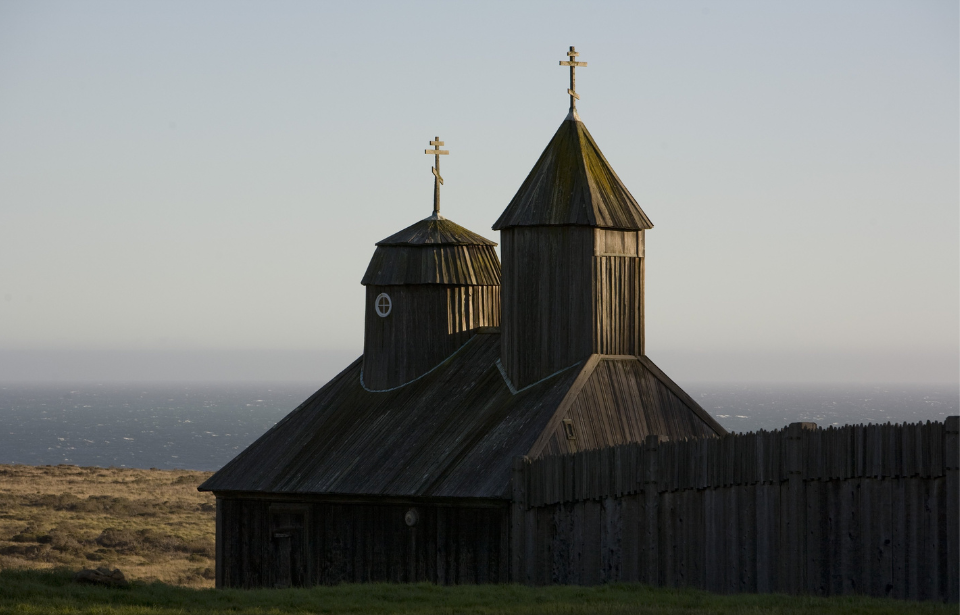Fort Ross, first known as Fortress Ross, was a Russian settlement on North America’s west coast, now Sonoma County, California. The Russian-American Company used Fort Ross between 1812 and 1841. As the southernmost Russian settlement in North America, it was one of the first multi-ethnic communities in northern California. Indigenous peoples from California and Alaska resided there along with the Russians.
Naming of the fort

Eugène Duflot de Mofras first used the name Fort Ross on his 1842 chart of California following his 1840 visit. The name of the fort is believed to come from the root words rus or ros, for the word Russia, Rossiya. According to William Bright, an American linguist, Ross is a “poetic name” for a Russian in the Russian language.
Although it has been suggested, there is no evidence that there is a connection between the use of Ross in naming the fort and the Scottish name.
Pre-Russian period

Before the arrival of the Russian settlers, the area that Fort Ross occupies was part of Kashaya Pomo territory. While the date of their arrival in the region, which they called “Metini,” is unknown, it has been estimated archaeologically between 1,000 and 500 BC.
Archaeological and ethnographic evidence suggests that the Kashaya Pomo peoples lived in large, likely permanent, villages throughout the region.
The Russian-American Company

The Russian-American Company (RAC) was a Tsarist Crown company created to control all Russian settlements and fur trade in the northern Pacific and North America. Founded in 1799, the RAC ceased operations following the American purchase of Alaska in 1867.
The Russians first arrived in California from their Alaskan colonies via American ships. Since 1803, American ship captains had been working in the sea otter fur trade, along with Russian supervisors and Indigenous Alaskans, hunting otters and fur seals along the Alta and Baja Californian coast. Russian reports from these hunting trips noted uncolonized areas that the RAC could utilize.
The region that would become Fort Ross seemed ideal. Its location was north of the Spanish settlements in present Southern California but was still southern enough that the Russians could grow crops for their Alaskan colonies. It also allowed for an expansion of their fur trade, which had been on the decline due to overhunting in Alaska. With this in mind, the RAC recommended a new settlement in California to Emperor Alexander.
Establishment of Fort Ross

A letter to the Russian emperor stated: “This settlement has been organized through the initiative of the Company. Its purpose is to establish a [Russian] settlement there or in some other place not occupied by Europeans and to introduce agriculture, thereby planting hemp, flax, and all manner of garden produce; they also wish to introduce livestock breeding in the outlying areas, both horses and cattle, hoping that the favorable climate… and the friendly reception on the part of the Indigenous people, will assist in its success.”
Fort Ross was therefore established by Commerce Counselor Ivan Kuskov of the RAC in 1812.
The rise and fall of Fort Ross

Once established, Fort Ross became a permanent and familiar fixture on the landscape. Inside the fort were three warehouses, a barracks, and three houses for officials, all made of local redwood. It soon became the site of a multi-ethnic community where Russians, Indigenous Alaskans, who were brought by the Russians, and local Kashaya Pomo peoples all lived in close proximity. And while the Fort was technically located in Spanish territory, it never came under attack.
As time progressed, the settlement was expanded with the later addition of a Russian Orthodox chapel, a shipbuilding yard, windmills, and an orchard for more food production. From Fort Ross, Russians hunted sea otters and sea lions for their fur. However, these populations were later exhausted, and Fort Ross expanded to include livestock and various crops.
Fort Ross was never as successful as its settlers had hoped it would be. Rocky soil, harsh climate, and the eventual depletion of the maritime mammals they hunted eventually saw the sale of the fort to John Sutter in 1841.
From privately owned to State Historic Park

Following the sale of the Fort to Sutter in 1841, the majority of the buildings were taken down and sold for their value as lumber. Sutter turned the area into a ranch but later sold it, which resulted in it passing through various private hands and eventually falling into disrepair. In 1906, the California Historical Landmark Commission bought Fort Ross and donated it to California State Parks.
The Fort has been almost completely restored, including parts that had been destroyed by fire. Fort Ross, as part of the Fort Ross State Historic Park, is “one of the most scenic coastal routes in the world,” according to the Fort Ross Conservancy. In addition to the historic fort, the 3,400-acre park boasts “sandy beaches, panoramic coves, and redwood forests, with breathtaking views of the Pacific Ocean.”
More from us: Japan Has Millions of Abandoned Houses – You Can Buy One for $25,000!
Fort Ross remains an impressive display of the far reaches of the Russian Empire into North America. Now, however, it has a convenient gift shop.
